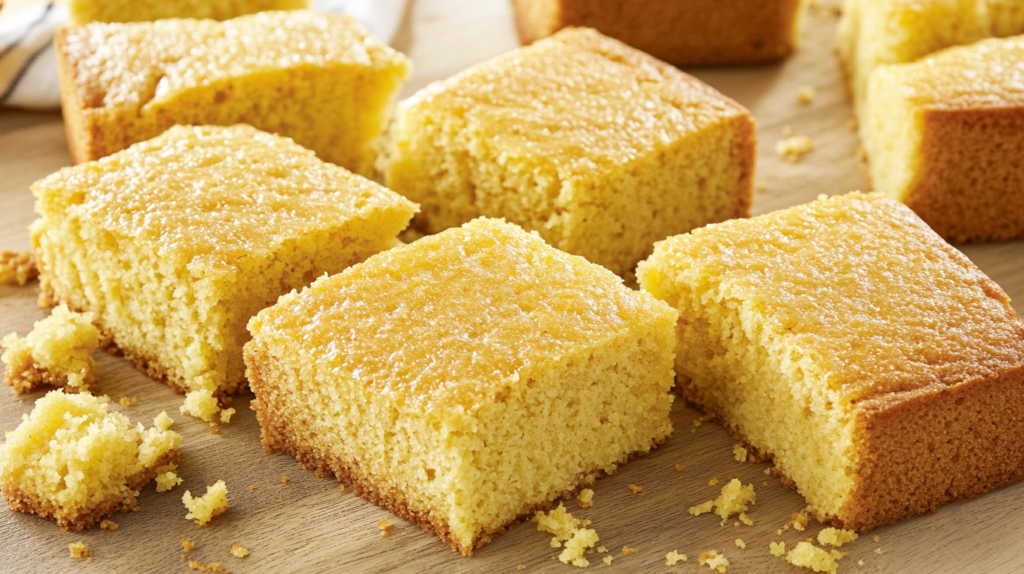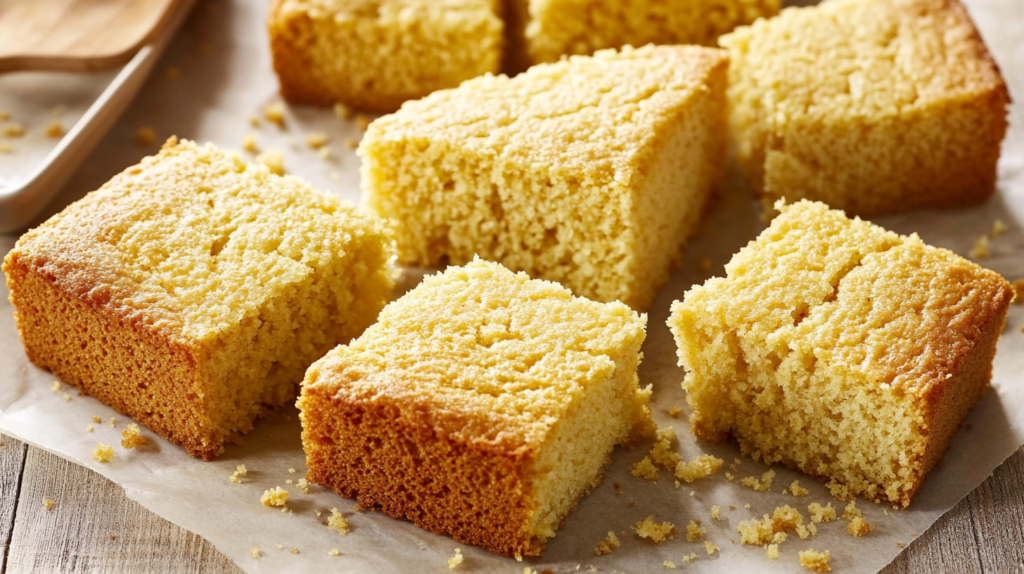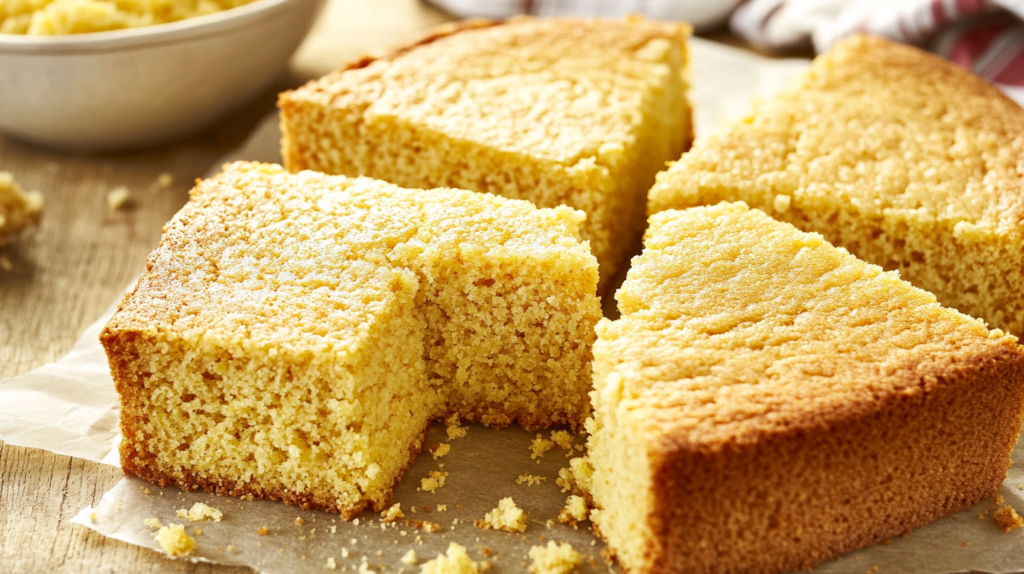I’ve baked cornbread many times, with both successes and failures. It’s really disappointing when it falls apart as soon as you touch it. But don’t worry, I’ve learned how to make cornbread that’s moist, sturdy, and delicious.
Related : No Egg Cornbread Recipe: Simple Southern Classic

Key Takeaways
- Understanding the role of gluten in cornbread structure
- Mastering the moisture-to-dry ingredient ratio for optimal texture
- Leveraging binding ingredients to prevent crumbling
- Avoiding common mistakes that lead to a dry, crumbly cornbread
- Ensuring proper pan selection and preparation for a sturdy result
In this guide, we’ll dive into the science behind achieving the perfect cornbread texture. We’ll explore the role of key ingredients and the best techniques to prevent it from crumbling. Additionally, we’ll share practical tips to ensure your cornbread remains consistently moist and tender every time. With these insights, you can confidently say goodbye to dry, crumbly cornbread for good and hello to delicious results!
Understanding the Science Behind Perfect Cornbread Texture
Making perfect cornbread is more than just following a recipe. It’s about knowing the science behind its texture. This includes the role of gluten and how temperature affects it. Let’s explore how to make cornbread that stays together without crumbling.
The Role of Gluten in Cornbread Structure
Gluten, found in wheat, is key to cornbread’s structure. Cornmeal is gluten-free, but adding wheat flour helps. This creates a strong network that traps air and keeps the cornbread together.
Moisture-to-Dry Ingredient Ratio
The right mix of wet and dry ingredients is crucial. Too much moisture makes cornbread crumbly, while too little makes it dry. Adjusting the cornbread binding ingredients and the moisture-to-dry ingredient ratio helps achieve the perfect texture.
Temperature Impact on Cornbread Stability
The baking temperature plays a crucial role in determining the stability and texture of cornbread. Baking at higher temperatures results in a crisp, cohesive crust, while lower temperatures extend the baking time, allowing the cornbread to become more stable throughout.
By understanding and adjusting these factors, you can consistently create cornbread that not only holds together but also impresses everyone with its perfect texture. It’s all about mastering the science behind baking for truly exceptional results.

Essential Binding Ingredients for Sturdy Cornbread
Creating cornbread that holds together beautifully without crumbling relies heavily on using the right combination of ingredients. Each key element works together to form a moist, cohesive texture that’s ideal for slicing and serving seamlessly. With the proper balance, your cornbread will maintain its structure while delivering the perfect bite every time.
Eggs are a must in cornbread recipes. They are full of protein, which helps mix wet and dry parts together. When baked, eggs form a strong structure that keeps cornbread firm.
Milk or other dairy products are also vital. They add moisture, keeping cornbread soft and not dry. The lactic acid in milk also makes the gluten strands tender, leading to a soft yet stable crumb.
- Eggs act as natural emulsifiers, binding the ingredients together
- Milk and dairy products provide moisture and tenderize the gluten
- Other binding ingredients like flour, cornmeal, and baking powder also play a crucial role
Flour, cornmeal, and baking powder are essential ingredients in cornbread recipes, each playing a significant role in achieving the perfect balance of structure and moisture. These ingredients work harmoniously to create a batter that bakes into moist cornbread with a firm, stable texture. By understanding their combined effects, you can consistently produce cornbread that holds its shape while remaining tender and delicious.

Knowing how these binding agents work helps you make cornbread with a tender yet sturdy crumb. This crumb won’t fall apart when sliced or served. Using these key ingredients is the first step to baking delicious and firm cornbread.
What Keeps Cornbread From Falling Apart?
Making a sturdy cornbread can be tricky. But knowing what goes wrong and how to fix it can help. The right ingredients and mixing methods are key to a cornbread that stays firm and tasty.
Common Mistakes That Lead to Crumbly Cornbread
- Overmixing the batter, which can develop too much gluten and result in a tough, dry texture
- Using too much cornmeal or not enough flour, leading to a lack of structure
- Underbaking the cornbread, leaving it undercooked and prone to falling apart
- Failing to allow the cornbread to cool completely before slicing, which can cause it to break apart
Key Ingredients That Act as Stabilizers
Some ingredients help prevent cornbread from crumbling. These include:
- Eggs, which act as a binder and help hold the cornbread together
- Buttermilk or sour cream, which provide moisture and acidity to strengthen the structure
- Flour, which balances the coarse texture of cornmeal and provides structure
- Baking powder and baking soda, which help the cornbread rise and set properly
Proper Mixing Techniques
How you mix the batter affects the cornbread’s texture and stability. Here are some tips:
- Avoid overmixing the batter, which can develop too much gluten and result in a tough, dry texture
- Gently fold in the wet ingredients to the dry ingredients, taking care not to overwork the batter
- Use a light hand when mixing, and stop as soon as the ingredients are just combined
- Allow the batter to rest for a few minutes before pouring it into the prepared pan
By avoiding common mistakes and using the right ingredients and techniques, you can make a cornbread that stays firm and delicious.
The Right Pan Selection and Preparation Methods
Selecting the right baking pan is essential for achieving the perfect cornbread. The type of pan you choose, along with proper preparation techniques, can significantly enhance the texture and overall quality of your cornbread. With the right pan, you can ensure it bakes evenly, turns out sturdy, and stays delicious without falling apart during slicing or serving.
The material and size of the pan matter a lot. Cast iron skillets are great because they distribute heat evenly and create a golden crust. Non-stick pans are also good, making it easier to remove the cornbread. Make sure the pan fits your recipe well to keep the cornbread structure right.
It’s also important to prepare the pan well. Grease it with butter, oil, or non-stick spray, covering the sides and bottom. This helps the cornbread come out easily after baking.
- Choose the right baking pan material and size for your cornbread recipe.
- Grease the pan thoroughly to prevent sticking and promote even baking.
- Consider using a cast iron skillet or non-stick baking pan for optimal cornbread texture.
By picking the right pan and preparing it well, you can make cornbread that’s perfect every time. You won’t have to worry about it falling apart.
Proper Measuring Techniques for Consistent Results
To make delicious cornbread, start with the right amounts of ingredients. It’s key to measure everything carefully to avoid dry cornbread. Whether you’re following your favorite cornbread recipes or trying to avoid dryness, measuring right is crucial.
Importance of Precise Ingredient Measurements
Baking cornbread successfully hinges on finding the perfect balance between wet and dry ingredients. Even small missteps in measurement can disrupt the texture and structure, leaving your cornbread less than ideal. However, by measuring ingredients with precision and care, you can consistently achieve cornbread that is moist, tender, and flawlessly baked every time.
Tools for Accurate Measuring
- Measuring cups and spoons for dry ingredients
- Digital food scale for precise weight measurements
- Liquid measuring cups for wet ingredients
- Leveling tools like straight edges to ensure accurate fill levels
Weight vs. Volume Measurements
Many cornbread tips suggest using cups and tablespoons. But, weighing ingredients can give you better results. Volume measurements can change due to how ingredients are packed. A digital scale helps you get the exact amount needed.
| Ingredient | Volume | Weight |
|---|---|---|
| All-Purpose Flour | 1 cup | 120g |
| Cornmeal | 1 cup | 150g |
| Granulated Sugar | 1 cup | 200g |
By focusing on precise measurements, you’ll get cornbread that’s always moist and perfect. With the right tools and methods, you can make cornbread that’s a hit every time.
Temperature Control: From Mixing to Baking
Getting the perfect cornbread texture starts with temperature control. It’s key from mixing to baking. The right temperatures ensure a sturdy, flavorful cornbread that stays together.
Let’s look at the important temperature points for making cornbread:
- Ingredient Temperatures: Make sure all ingredients are at room temperature before mixing. This helps with even hydration and gluten development, crucial for cornbread’s texture.
- Mixing Temperature: Mix the batter at a moderate temperature, about 70-75°F (21-24°C). Avoid hot or cold temperatures to prevent dryness or uneven baking.
- Baking Temperature: Preheat the oven to 400-425°F (204-218°C). Bake until a toothpick in the center comes out clean. High heat sets the structure and gives a golden crust.
By controlling temperatures, you’ll get the cornbread texture and perfect cornbread you want. You’ll need just a few cornbread tips.
“Temperature is the unsung hero of cornbread baking. Get it right, and you’ll be rewarded with a sturdy, delicious loaf every time.”
Moisture Management in Cornbread Baking
Achieving the perfect cornbread texture requires carefully balancing the mix of moist and dry ingredients. If the moisture level is off, the cornbread may become crumbly and prone to falling apart. However, by mastering the art of moisture management, you can ensure your cornbread stays delightfully moist while holding its shape perfectly, creating a consistent and enjoyable dish every time.
Balancing Wet and Dry Ingredients
The secret to avoiding dry, crumbly cornbread is to get the wet to dry ingredient ratio just right. Too much liquid makes it dense and gummy, while too little makes it dry and crumbly. Try adjusting the amounts of buttermilk, eggs, and oil to find the perfect cornbread texture for you.
Humidity Considerations
Humidity in your kitchen also affects your cornbread. High humidity can make the batter too wet, leading to a dense crumb. On the other hand, low humidity can dry out the cornbread, making it crumbly. Keep an eye on your kitchen’s humidity and adjust your ingredients to get the perfect moist cornbread.
| Humidity Level | Cornbread Texture Impact |
|---|---|
| High Humidity | Dense, heavy crumb |
| Low Humidity | Dry, crumbly texture |
Understanding moisture management and making the right adjustments can help you bake moist cornbread every time. Your cornbread will stay moist and have the perfect texture.
Cooling and Storage Tips for Maintaining Integrity
Getting the perfect cornbread texture is just the start. Keeping your cornbread fresh is key. Here are some cornbread tips to help you do just that.
First, let your cornbread cool completely before slicing. This step is crucial for a solid crumb. After baking, let it sit for at least 15 minutes before touching it.
- Don’t cut into the cornbread until it’s room temperature. This helps it keep its shape.
- For the best results, cool the cornbread on a wire rack. It cools evenly and keeps the bottom from getting soggy.
Storing your cornbread right is important for keeping it fresh. Here’s how to keep it moist and prevent it from drying out.
- Put cooled cornbread in an airtight container or plastic bag. This keeps moisture in and prevents staleness.
- If you’re storing it for a few days, slice it first. This makes it easy to grab a slice without messing up the whole loaf.
- Don’t leave cornbread at room temperature for too long. Refrigeration is best for keeping it fresh longer.
By following these easy tips, your homemade cornbread will stay delicious for days. Enjoy your cornbread texture and cornbread tips every time.
Troubleshooting Common Cornbread Problems
Baking the perfect cornbread can be tricky, even for experts. We’re here to help with two big issues: dry, crumbly cornbread and problems from over-mixing.
Fixing Too-Dry Cornbread
Too-dry cornbread often comes from not enough moisture. To fix this, try a few simple changes:
- Add a bit more liquid, like milk, buttermilk, or eggs.
- Include an extra tablespoon or two of oil or melted butter for moisture.
- Don’t overbake. Check if it’s done a few minutes early.
Addressing Over-mixing Issues
Over-mixing can make cornbread tough and dense. Here’s how to avoid it:
- Mix dry and wet ingredients separately. Then, gently fold them together until just combined. Avoid stirring too hard.
- Be careful with add-ins like cheese, bacon, or jalapeños. They can make the batter over-mixed.
- Use a light touch when mixing. Stop as soon as everything is just combined. Too much mixing can make it tough.
With these tips, you’ll soon be baking moist, crumbly-free cornbread. A bit of practice and attention to detail will make your cornbread a hit with everyone.
“The secret to perfect cornbread is all in the technique. Follow these tips, and you’ll never have to worry about crumbly, dry cornbread again.”
Conclusion
In this guide, you’ve learned how to make cornbread that doesn’t fall apart. You now know the science behind a perfect texture. You also know how to use binding ingredients and control temperature and measurements.
Understanding how to manage gluten and keep the right moisture balance is key. Using eggs and buttermilk helps too. By avoiding mistakes and following the right steps, your cornbread will stay firm.
Keep practicing and trying new things as you bake. This will help you find the cornbread recipe you love. With a bit of effort, you’ll make cornbread that looks great and tastes amazing for everyone to enjoy.
FAQ
What keeps cornbread from falling apart?
Cornbread stays together thanks to eggs and milk. The right mix of wet and dry ingredients is key. Avoid over-mixing and choose the right pan. Temperature and cooling methods also play a role.
What are the essential binding ingredients for sturdy cornbread?
Eggs, milk, and dairy products are crucial. They add structure and moisture, keeping the cornbread cohesive.
How does the moisture-to-dry ingredient ratio affect cornbread texture?
Achieving the right balance between wet and dry ingredients is critical. Too little liquid results in a dry and crumbly texture, while too much can make the cornbread dense and heavy. Striking the perfect ratio guarantees a moist, tender crumb.
What are some common mistakes that can lead to crumbly cornbread?
Over-mixing, too much flour, and wrong temperatures can cause crumbliness. Proper mixing and temperature control are key to avoiding these issues.
How does the type of baking pan affect cornbread texture?
The baking pan’s material and size significantly influence cornbread texture. Cast-iron skillets create a crispy outer crust with a moist interior, while lighter pans promote even baking, resulting in a tender crumb.
Why is precise ingredient measurement important for consistent cornbread results?
Accurate ingredient measurement is essential for consistent results. Even small deviations in quantities can alter the texture, moisture level, and overall structure of your cornbread.
How does temperature control affect cornbread texture?
Temperature management is crucial at every stage, from mixing to baking and cooling. The right temperatures ensure the cornbread bakes evenly, preventing dryness and crumbling while delivering a perfectly tender texture.
What tips can help with moisture management in cornbread baking?
To maintain moisture, balance wet and dry ingredients carefully and consider factors like humidity. Covering the pan during baking or adjusting ingredient ratios can further prevent dryness and enhance texture.
How can you troubleshoot issues with too-dry cornbread?
If your cornbread turns out too dry, add more milk or buttermilk to the batter for future attempts. To salvage it, brush the top with melted butter or honey. Additionally, reducing baking time and monitoring oven temperature can help prevent dryness.

